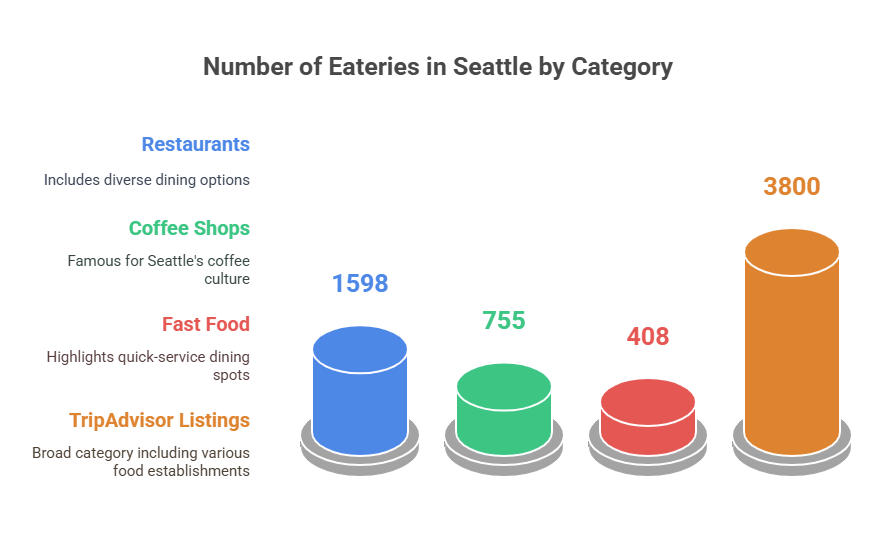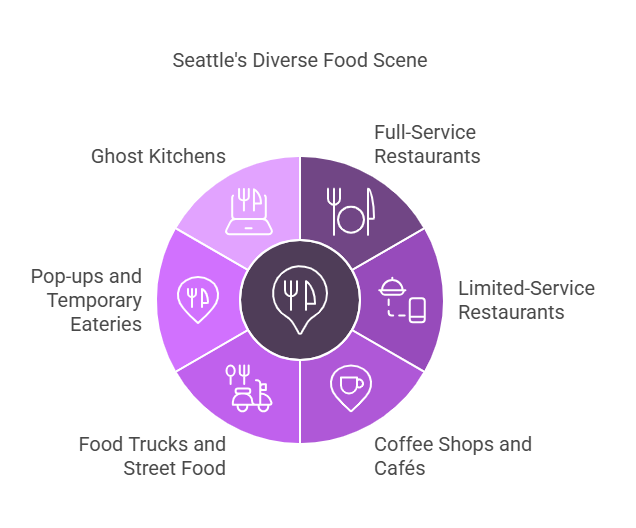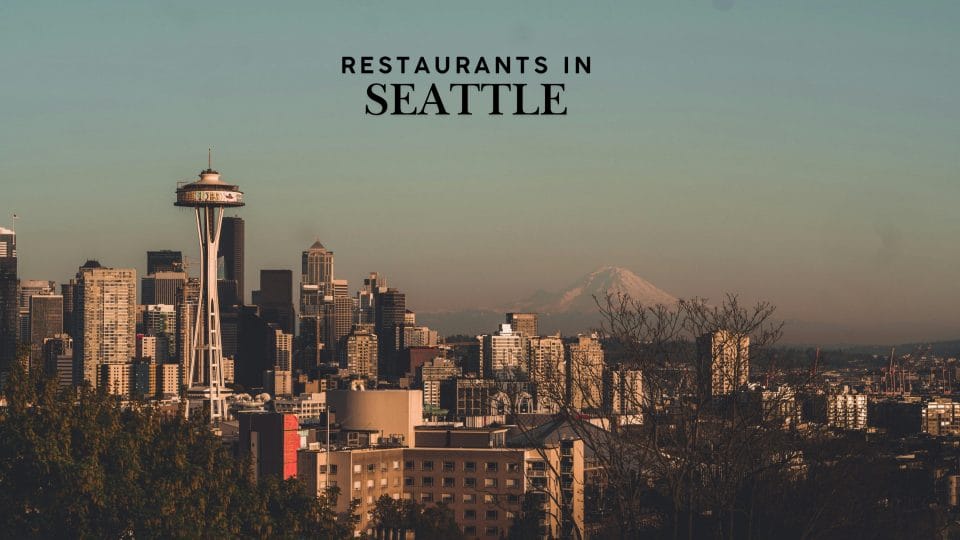Key Takeaways:
- Washington state has ~16,300 eating and drinking establishments, with Seattle accounting for 20–25% of them.
- Google Maps listed 1,598 restaurants in Seattle as of January 2025, with ~67% being independent and ~33% chain-affiliated.
- Seattle also has 755 coffee shops, making the combined total of food-and-drink listings over 2,300 online.
- Fast food restaurants number around 408, mostly chain-based, and partially overlap with the restaurant count.
- TripAdvisor lists ~3,800 Seattle establishments, reflecting a broader definition that includes cafes, food trucks, and dessert spots.
- Seattle likely has between 2,500 and 3,800 restaurants, depending on inclusion criteria (e.g., ghost kitchens, pop-ups, coffee shops).
- Downtown, Capitol Hill, Ballard, and Fremont are the most densely packed with eateries.
- Discrepancies in restaurant counts stem from different definitions, data sources, and counting methods, such as inclusion of mobile vendors or delivery-only brands.
Looking at Washington’s state data overall, the National Restaurant Association reports about 16,300 eating and drinking places in Washington state as of 2024.
Being the largest city, Seattle hosts a significant chunk of those. It wouldn’t be a stretch to say Seattle proper accounts for roughly one-fifth to one-quarter of the state’s restaurant locations.
Official Records: Business Licenses and City Data
One way to count restaurants is by looking at official business registrations. According to Seattle city records, there were over 4,000 active business licenses for food service businesses in Seattle as of early 2020. This figure includes restaurants, caterers, and other food-related businesses. In other words, roughly four thousand entities in the city had an active license to serve food at that time.
It’s important to note that this official count isn’t limited to sit-down restaurants. It also includes caterers, food service contractors, and possibly bars or breweries that serve food. Essentially, any business in the “food industry” with a license falls under this umbrella.
So, while “4,000+” gives a sense of scale, it’s a broad figure. The actual number of places the average person would recognize as a restaurant (think cafes, bistros, fast food joints, fine dining, etc.) is a bit lower once you exclude things like corporate caterers or maybe bakery wholesalers.
Restaurants Listed Online (Google, TripAdvisor, etc.)
Another way to estimate the number of restaurants is to see how many are listed in popular directories or map services that people use to find food. These sources often exclude businesses like caterers or institutional food services and focus on places regular folks go to eat or drink.
- Google Business Profiles / Google Maps: A recent data scrape of Google listings counted 1,598 restaurants in the city of Seattle (as of January 23, 2025). This likely includes eateries that identify as restaurants on Google – from upscale dining rooms to casual lunch spots. Interestingly, of those 1,598 restaurant listings, about 66.7% were independent businesses and ~33% were part of chains or larger brands. This shows Seattle’s dining scene is dominated by local, single-location restaurants, with about one-third being franchise or chain outlets.
- Coffee Shops and Cafés: Seattle is famous for its coffee culture, so how do coffee-centric spots factor in? They might not all be labeled as “restaurants” on Google. In that same dataset, there were an additional 755 coffee shops in Seattle (as of early 2025). These would be places like Starbucks, local cafés, and tea shops. Many of these serve food (pastries, light bites), but some lists count them separately. If we add those to the restaurants count, we get over 2,300 eateries when combining restaurants and coffee shops listed online.
- Fast Food and Quick-Service: What about the burger joints and taco stands? A separate tally for fast food restaurants in Seattle came up with 408 fast-food restaurants as of January 2025. This category overlaps a bit with the general “restaurants” count, but it specifically highlights the quick-service spots (and indeed most of these – about 79% – are part of big brands or chains). Many fast food outlets might already be included in the 1,598 Google count, but this gives an idea that a few hundred of Seattle’s eateries are your classic fast-food or fast-casual places.
- TripAdvisor: TripAdvisor, a travel review site, lists around 3,800 establishments in Seattle under its restaurant category. This number (3.8k) likely includes everything from food trucks to fine dining, and might even count cafes, dessert shops, and bar-restaurants. It’s a high-end estimate of how many places a tourist might find when looking for “where to eat in Seattle.”

Why the discrepancy between Google’s ~1,600 and TripAdvisor’s ~3,800? The definition and inclusion criteria differ. Google’s scrape may have been stricter about Seattle city limits or specific categories.
TripAdvisor tends to cast a wide net – including every place visitors might review. It might include bars, bakeries, food counters in markets, and perhaps businesses just outside city limits marketed under “Seattle”.
Also, TripAdvisor doesn’t require a business to claim a profile – so even a hole-in-the-wall that never set up a Google listing might still get listed on TripAdvisor if a traveler reviewed it.
It’s likely that TripAdvisor’s 3,800 includes many cafes, donut shops, and duplicates in terms of multi-category listing (for example, the same cafe might show up under “Dessert” and “Restaurant”).
To sum up the online listings: Seattle likely has on the order of 2,000–3,000 consumer-facing dining establishments when you combine full-service restaurants, fast food joints, and coffee shops. That aligns with the notion that the city has “over 3,000 restaurants” in casual parlance, even if not all of those are full-service sit-down places.
Types of Food Establishments: Breaking Down the Numbers
Not all “restaurants” are alike – Seattle’s food scene runs the gamut from fine dining to food trucks. Here’s a breakdown by category, with what we know about each:

1. Full-Service Restaurants
These are traditional sit-down restaurants where you have a waiter, and they range from upscale dining rooms to family-run diners. A large portion of Seattle’s ~1,600 Google-listed restaurants fall in this category.
Nationally and statewide, full-service establishments usually make up about half of all eating places. Seattle likely has on the order of a thousand full-service restaurants, give or take, if we separate out the others. These include everything from steakhouses and sushi bars to neighborhood bistros.
2. Limited-Service Restaurants (Fast Casual and Fast Food)
This category includes fast food chains, takeout spots, and cafes where you order at a counter. Seattle has around 400 fast-food restaurants by one recent count, but limited-service also includes many fast-casual and boutique takeout eateries that aren’t part of big chains.
When you add all the sandwich shops, pizza counters, teriyaki joints, and food court vendors, the total number of limited-service eateries is likely several hundred. Many of these are included in the “restaurants” or “fast food” tallies above. They are the grab-and-go places or quick lunch spots that are everywhere from Downtown to the neighborhood strip malls.
3. Coffee Shops and Cafés
With about 755 coffee shops in Seattle, this is a major category on its own. While some might argue a coffee shop isn’t a “restaurant,” they are certainly part of the food and drink landscape. Seattle’s café count is high (no surprise for the home of Starbucks!).
These range from tiny independent espresso bars to large café-bakeries. Some have full menus, others just pastries and snacks. If you included all these in the “restaurant” count, it boosts the numbers significantly. (Many official counts don’t explicitly break these out, but TripAdvisor and others include them.)
4. Food Trucks and Street Food
Seattle’s food trucks deserve their own mention. On any given day, there are over 300 food trucks operating in Seattle and the surrounding metro area. Food trucks are mobile and seasonal – some only come out in summer, others operate year-round rotating through neighborhoods. They typically do require permits and health inspections, but a truck might not have a “Seattle business license” if it’s based in a nearby city and just rolls in for lunch service.
The King County health department, which oversees inspections, has a database of mobile food vendors. There’s no single definitive count of how many distinct trucks serve Seattle, but a few hundred is a good estimate. Food trucks are a growing segment, but they often don’t show up in static “restaurant count” statistics due to their mobility and licensing quirks.
5. Pop-ups and Temporary Eateries
Seattle’s culinary scene also features pop-up restaurants – temporary dining events or short-term eateries, often hosted inside existing restaurants or bars during off-hours. These are not usually counted in any official or unofficial tally because they don’t have a permanent location or separate business license.
A Chef might do a weekend pop-up inside another restaurant’s kitchen. They add to the diversity of Seattle’s food options but are practically invisible in the numbers. Think of them as the “gray area” – vibrant but uncounted.
6. Ghost Kitchens (Delivery-Only Restaurants)
In recent years, ghost kitchens (also known as cloud kitchens or virtual restaurants) have made an appearance in Seattle. These are commercial kitchens that produce food solely for delivery or pickup, with no dine-in space. They often operate multiple “virtual brands” from one location.
From a business license perspective, some ghost kitchen facilities might have one license but launch 5–10 different restaurant brands out of the kitchen. For example, a single ghost kitchen building in Seattle’s SoDo neighborhood could house a dozen delivery-only restaurant brands, none of which have a storefront sign.
Counting these is challenging. They may be undercounted in Google/TripAdvisor if they aren’t listed or if customers don’t review them as distinct restaurants.
However, they are part of the official count if each brand is a separate business entity with its own license. It’s safe to say ghost kitchens add dozens of “restaurants” to Seattle’s total, but they’re behind the scenes. This partly explains why an official license count might be higher than the number of places you can physically spot on the street – some are essentially virtual.
In summary, Seattle’s “restaurant” universe encompasses everything from a coffee kiosk at Pike Place Market, to the food truck serving tacos at Westlake, to the chic tasting-menu spot on Capitol Hill, to an Instagram-only cupcake bakery operating out of a shared kitchen. What gets counted depends on who’s doing the counting.
Neighborhood Breakdown
Seattle is a city of neighborhoods, each with its own character – and cuisine. While precise counts by neighborhood aren’t readily published, we can highlight where the concentrations are:

Downtown & Waterfront
The Downtown core (including areas like Belltown, Pike Place Market, and Pioneer Square) has the highest density of restaurants. Tourists and office workers mean lots of eateries packed into a small area.
Pike Place Market alone contains dozens of food vendors and restaurants. If one were to estimate, the greater downtown area likely hosts several hundred restaurants, from steakhouses to sandwich shops.
Capitol Hill & First Hill
Just up the hill from downtown, Capitol Hill is known as a foodie hotspot and nightlife district. It’s brimming with trendy restaurants, bars that serve food, and cafes. You’ll find everything from vegan diners to high-end izakayas.
A local might say you could eat out every night for months on Capitol Hill and not run out of options. While an exact count isn’t published, it’s safe to say Capitol Hill has dozens upon dozens of restaurants, likely well over a hundred if you include every cafe and late-night bite.
Ballard and Fremont
In the northwest part of the city, Ballard is famous for seafood (historically a fishing neighborhood) and its brewery scene – and along with that comes many brewpubs, seafood joints, and hip eateries. Adjacent Fremont and Wallingford also have a rich collection of restaurants (from Ethiopian to sushi).
Combined, these neighborhoods host a significant share of Seattle’s independent restaurants. Strolling Ballard Avenue on a weekend, you’ll pass scores of establishments door-to-door.
University District & North Seattle
The U-District around the University of Washington has lots of affordable eats catering to students – think ramen shops, sandwich cafes, boba tea and pizza places. While many are smaller in size, the number of food businesses around the U-District is quite high (students need to eat!). Further north, neighborhoods like Greenwood, Green Lake, and Northgate each have their clusters of restaurants, though more spread out.
West Seattle
Across the bay (but still part of the city), West Seattle neighborhoods like the Junction and Alki have a robust dining scene of their own. You’ll find waterfront seafood restaurants on Alki Beach and a mix of cafes and eateries in the Junction and Admiral areas. West Seattle might have on the order of a few dozen notable restaurants, adding to the city’s total.
International District (Chinatown-ID)
This historic neighborhood just south of downtown is packed with restaurants – Chinese, Japanese, Vietnamese, Filipino, and more. The ID is a smaller geographic area but dense with eateries (dim sum halls, noodle shops, bakeries, etc.). It’s one of the city’s culinary gems and certainly contributes a large number to the overall restaurant count (the district likely contains well over 50 food businesses by itself).
Practically every corner of Seattle has some restaurants – from Magnolia’s village cafes to Rainier Valley’s diverse mom-and-pop eateries.
However, the bulk of the restaurant count is concentrated in the central neighborhoods (downtown, Capitol Hill, etc.) and other popular commercial districts. Residential-only areas have few or no restaurants, but those are relatively small pockets in Seattle.
(If one had to divvy up the ~3,000+ restaurants citywide among areas, you might find a thousand or more in the greater downtown + Capitol Hill area, another several hundred in each of the other major zones like north Seattle, west Seattle, and so on. The exact breakdown would require more granular data, but the key point is that eateries are not evenly distributed – some neighborhoods are foodie destinations with high concentrations.)
Why Do Different Sources Report Different Numbers?
By now it’s clear that the answer to “how many restaurants are in Seattle?” can vary. Here are a few reasons for the discrepancies:
Definition of “Restaurant”
Official counts include any business serving food (and sometimes drink). This means the city’s number will count a hospital cafeteria or an ice cream truck as much as a Michelin-starred restaurant.
Conversely, a count from a travel website might include only places that travelers review (skipping school cafeterias, etc.), but it might include coffee shops and bakeries that a strict NAICS code count might classify separately.
Some sources may or may not include bars that serve food, food trucks, or chain coffee outlets. The inclusion or exclusion of certain categories can swing the total by hundreds.
Geographic Boundaries
Seattle’s city limits are distinct, but some restaurant listings might include greater Seattle area or suburbs if not careful. For example, a Google search constrained to the city will exclude a famous diner just over the city line in Shoreline, whereas a tourism site might lump it in as “Seattle” in a broader sense.
The TripAdvisor 3,800 figure is likely strictly within city limits (since TripAdvisor has separate pages for nearby suburbs), but one must always ensure we’re comparing the same geographic area.
Data Freshness and Closures
Restaurants open and close frequently. A city license database might still list a business as active until the license lapses, even if the restaurant shut its doors last month. Online platforms might have outdated listings (a restaurant that closed in 2024 might still show up unless marked closed).
During the pandemic, many closures occurred, and not all sources updated immediately. So, timing matters. The numbers from 2025 show an increase from 2023 – for instance, the Google-based data noted a 1.37% increase in Seattle restaurants from 2023 to 2025rentechdigital.com, which suggests gradual growth.
If one source uses 2022 data and another uses late-2024 data, the latter will show more restaurants (as the industry rebounded).
Duplicate Counting vs Unique Counting
If a business has multiple licenses or multiple listings, it can confuse counts. For example, one physical location might host two restaurants (a daytime cafe and a nighttime pop-up) – do we count it as one or two? The city would count one license typically.
But online you might see two names. Conversely, a chain like Starbucks might have dozens of locations – each is a “restaurant” location in official terms (and indeed the city’s coffee shop count includes hundreds of chain outlets), but some people might colloquially think of “Starbucks” as one entity. Most counts we’ve discussed do treat each location as a separate establishment, as they should for clarity.
Ghost Kitchens and Virtual Brands
As discussed, ghost kitchens can make counting difficult. For example, a single ghost kitchen facility might appear as one address in a license database but operate 10 brands on UberEats.
A person asking “how many restaurants” might not even think of those virtual brands, but they are part of the ecosystem. Some sources might exclude them (if not aware of them), leading to lower counts.
As of 2025, ghost kitchens are still a relatively small fraction of Seattle’s total, but they exemplify how the concept of a restaurant is changing, making it harder to count with traditional methods.
Human vs Automated Counting
A fun point – if a journalist or blogger says “Seattle has over 3,000 restaurants”, that might be a rounded figure based on some data or just a general impression from combining categories. Meanwhile, an automated scrape like the Rentech Digital data gives a very precise number (1,598 restaurants, 755 cafes, etc.).
Precision isn’t always accuracy though – it depends if the scrape missed some or mis-classified some. Always consider the source: an official might give a rounded number for simplicity, whereas a database might give an exact count of entries that meet certain filters.
They could both be “right” in context but still differ.
Conclusion: Seattle’s Culinary Count in Context
For an Australian reader (or anyone curious), the key takeaway is that Seattle has on the order of a few thousand places to eat and drink. Whether the number is 2,500 or 3,800 depends on definitions, but it’s certainly a hefty amount for a city of Seattle’s size (population ~750,000).
By comparison, a much larger city like New York has tens of thousands of restaurants, so Seattle’s count in the low thousands is plausible and expected for a major U.S. city known for food.




